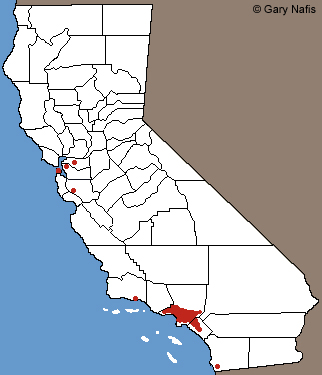 Red
Red: General areas where this species has been
found and may be established in California.
Click on the map for a topographical view
Map with California County Names
|
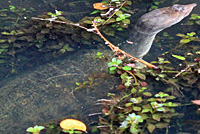 |
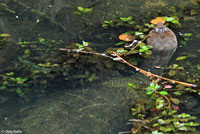 |
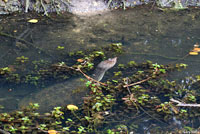 |
| |
Adult, Collier County, Florida |
|
| |
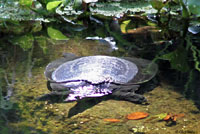 |
|
| |
Adult, Sarasota County, Florida |
|
| |
|
|
|
Description |
|
| Size |
The largest species of softshell turtle in North America. Females range from 11-26.5 inches in length (28-67.3 cm). Males range from 6 - 12 3/4 inches in length (15.2-32 cm). (Powell et all 2016)
Nesting females were found to weigh an average of 14.7 pounds.
Hatchlings are 1.4 to 1.73 inches (36-44 mm) in length with a lighter carapace than adults with yellow and orange markings and a carapacial rim. Yellow and orange stripes are also found on the face and neck. The plastron is darker in color than that of adults.
|
| Appearance |
A large mainly aquatic turtle with a round and flattened body with a leathery carapace with no keel and a long snorkel-like snout with ridges on the nostrils. Sometimes longitudinal ridges are present. Several rows of small blunt tubercles on the front of the carapace extend back as far as the forelimbs.
Head and limb color is a nearly uniform dark brown, brownish gray, or olive with vague dark spots and blotches and broken stripes. The plastron is white or cream-colored. Feet are strongly webbed. A male's tail is long with the anal vent near the tip. A female's tail is short, barely extending beyond the edge of the carapace.
|
| Life History and Behavior |
Almost entirely aquatic. Fast-moving, and well-camouflaged.
In California, active from March through fall with peak activity in May and June. Not active in Winter.
Often seen in daylight in shallow water with only its head visible. Can remain submerged for long periods.
In its native range, often hunted for its meat. |
| Defense |
Releases foul-smelling musk and bites.
Buries itself in sandy and muddy substrates to hide from danger. |
| Predators |
| In its native range, predators include alligators and raptors, with egg predators including crows, foxes, otters, raccoons, and skunks. |
| Lifespan |
26 years is the maximum recorded lifespan. (Wikipedia)
|
| Diet |
| Omnivorous, consuming plant material, but mostly carnivorous, eating invertebrates including mollusks and crustaceans, and aquatic vertebrates including frogs, snakes, and fish. Also scavenges dead organisms. |
| Reproduction and Young |
Adults become sexually mature anywhere from 5 - 8 years of age.
In its native range mating occurs in spring with nesting taking place in June and July. Females can produce 4-5 clutches of an average of 20 eggs per season. Eggs incubate in 60-90 days. In its native range, females often lay eggs in the nests of alligators.
|
| Habitat |
Found in lakes, ponds, canals, marshes, roadside ditches, springs, quiet stretches of rivers and creeks. Prefers waters with sandy or muddy bottoms. Can tolerate some brackish environments. Not found in water with strong currents. Prefers slow-moving or still water.
"In CA, associated with ponds in public gardens or parks, often mixed with other exotic species such as Pond Sliders." (Hansen and Shedd, 2025)
|
| Range |
Native Range is most of Florida, including Big Pine Key where it is possibly introduced, north to South Carolina, southern Georgia, and Mobile Bay in Alabama.
In California, found mostly in the San Francisco Bay Area and the Los Angeles Basin in areas with large populations. Apparently established in some locations where multiple turtles have been observed.
All specimens found appear to be the result of the illegal release of unwanted pet turtles with no evidence to indicate that Florida Softshells are moving from their sites of introduction and colonizing new areas.
|
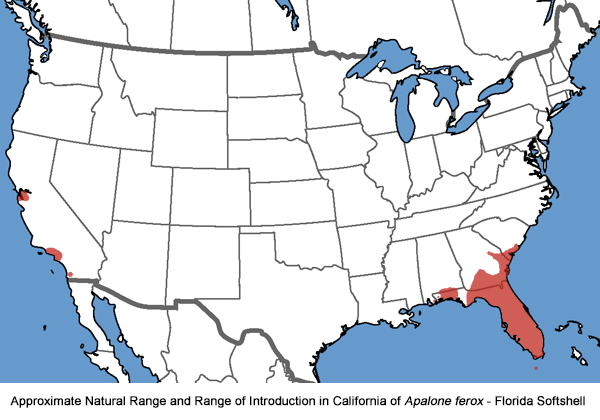 |
Notes on Taxonomy |
Alternate and Previous Names (Synonyms)
Florida Softshell Turtle
|
| Conservation Issues (Conservation Status) |
| Breeding might have occurred at some locations where multiple turtles have been observed, but it is not known if this species has become established yet in California or what effect introduced populations could have on native wildlife. |
|
Taxonomy |
| Family |
Trionychidae |
Softshell Turtles |
Bell, 1828 |
| Genus |
Apalone |
North American Softshells |
Rafinesque, 1832 |
Species
|
ferox |
Florida Softshell (Turtle) |
(Schneider, 1783) |
|
Apalone - Rafinesque, 1832 - Atlantic J. Friend Knowledge Philadelphia, Vol. 2, No. 2, p. 64
Apalone ferox - (Schneider, 1783) - Naturg. Schildkr., p. 330
from Original Description Citations for the Reptiles and Amphibians of North America © Ellin Beltz
|
Meaning of the Scientific Name
|
Apalone - Greek - apalos = soft, tender - referring to the soft shell
ferox - Latin = wild, savage - refers to the ferocious disposition attributed to the species
from Scientific and Common Names of the Reptiles and Amphibians of North America - Explained © Ellin Beltz
|
Related or Similar California Herps
|
The only similar turtle in California is the introduced Spiny Softshell, Apalone spinifera which has been established widely in the state. Florida Softshells have tubercles on the front of the carapace which are not present on the Spiny Softshell.
|
More Information and References
|
Robert Powell, Roger Conant, and Joseph T. Collins. Peterson Field Guide to Reptiles and Amphibians of Eastern and Central North America. Fourth Edition. Houghton Mifflin Harcourt, 2016.
Hansen, Robert W. and Shedd, Jackson D. California Amphibians and Reptiles. (Princeton Field Guides.) Princeton University Press, 2025.
Bartlett, R. D. & Patricia P. Bartlett. Guide and Reference to the Turtles and Lizards of Western North America (North of Mexico) and Hawaii. University Press of Florida, 2009.
Carr, Archie. Handbook of Turtles: The Turtles of the United States, Canada, and Baja California. Cornell University Press, 1969.
Ernst, Carl H., Roger W. Barbour, & Jeffrey E. Lovich. Turtles of the United States and Canada. Smithsonian Institution 1994.
(2nd Edition published 2009)
|
|
|
The following conservation status listings for this animal are taken from the July 2025 State of California Special Animals List and the July 2025 Federally Listed Endangered and Threatened Animals of California list (unless indicated otherwise below.) Both lists are produced by multiple agencies every year, and sometimes more than once per year, so the conservation status listing information found below might not be from the most recent lists, but they don't change a great deal from year to year.. To make sure you are seeing the most recent listings, go to this California Department of Fish and Wildlife web page where you can search for and download both lists:
https://www.wildlife.ca.gov/Data/CNDDB/Plants-and-Animals.
A detailed explanation of the meaning of the status listing symbols can be found at the beginning of the two lists. For quick reference, I have included them on my Special Status Information page.
If no status is listed here, the animal is not included on either list. This most likely indicates that there are no serious conservation concerns for the animal. To find out more about an animal's status you can also go to the NatureServe and IUCN websites to check their rankings.
Check the current California Department of Fish and Wildlife sport fishing regulations to find out if this animal can be legally pursued and handled or collected with possession of a current fishing license. You can also look at the summary of the sport fishing regulations as they apply only to reptiles and amphibians that has been made for this website.
This turtle is not included on the Special Animals List, which indicates that there are no significant conservation concerns for it in California.
|
| Organization |
Status Listing |
Notes |
| NatureServe Global Ranking |
|
|
| NatureServe State Ranking |
|
|
| U.S. Endangered Species Act (ESA) |
None |
|
| California Endangered Species Act (CESA) |
None |
|
| California Department of Fish and Wildlife |
None |
|
| Bureau of Land Management |
None |
|
| USDA Forest Service |
None |
|
| IUCN |
|
|
|
|







